Menus
Closely derived from competition, the Kawasaki KX 250 F and KX 450 F combine innovations and off-road performance. Struggling at the best level, they are improving their suspensions again this year and adopting some improvements, both technically and aesthetically.. Detailed review through a beginner’s eye.
Welcome to earth
Like many road bike enthusiasts, I classify offroad enthusiasts in the ranks of equilibrists, dusty or muddy depending on the weather. People hardly social, whose only goal is to dirty their machine and drive on accident-prone surfaces. In short, I admire them tinged with incomprehension, with a vague desire to imitate them…. one day.
Things could have stopped there…. but here it is, before a few days of summer vacation, Mr. Editor-in-Chief suddenly said to himself: "It would be good if Mr. Cleaner came down to earth and got his boots dirty (and the rest) a little." Then he added: "you’ll see, it’s a test of enduro-type motorcycles…." The deceitful! In fact, it was kind of rather if not really Cross. And not just any: Kawasaki KX, crampon legends led by the Green Team, home offroad professionals, for 40 years. This internal structure makes it possible to detect and train very young drivers to make them future stars of the discipline. In addition, the Akashi brand offers an evolving range, to train and gain strength over the years. For 2014, it is the 85, 250 and 450 cc models that the manufacturer is re-adjusting with some improvements. So here I am designated to dive, around Frankfort sur Main (with our Teutons friends with pacifiers), in this world parallel to mine. These motorcycling universes are ultimately not very transverse or miscible. We are either of one or the other but quite rarely of both. As evidenced by my colleagues of circumstance, having for the most part never driven on the asphalt…. For them I am, in the strict sense, an "extraterrestrial" just as much as they seem to me to be unbridled "out of bitumen".
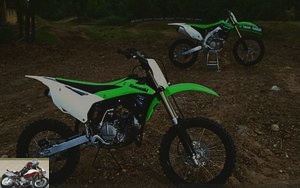
Discovery KX 250 F and 450 F
While waiting for the field infrastructures to be ready, I will detail the green novelties. For this 2014 vintage, we first note slight aesthetic alterations to the two machines, largely similar in appearance. The design of the racing plate as well as the mudguards is more dynamic, the rear element is no longer green but white, like the factory models. With a reduced capacity (only 6.1 L, small for a backpacker) and less tall, the tank now fits better in line with the saddle. Composed of urethane for better longevity, its upper is made of a non-slip surface for better support when sitting. Its smooth sides promote the mobility of the pilot. Likewise, the smaller container allows you to sit more forward..
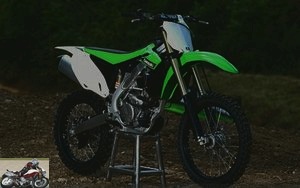
This notion of dynamic ergonomics prevails in the design of almost binoculars. Thus, the aluminum perimeter frame, combining forged, cast and extruded sections, is now 4 mm narrower between the main beams. It then widens at the ankles to better grip the machine, and narrows again under the saddle to refine the riding position. The different surface effects of this framework (satin, rhodium) reinforce the competition aspect of the Kawa. Doubling at its base, the structure also accommodates engine protection elements in the center and side, in plastic material..
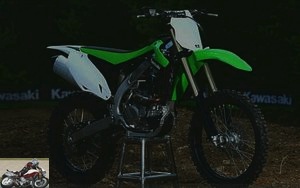
Minimalist, the casing also improves the ergonomics and control of the KX. Sidewalls and scoops are now narrower at the point of contact with the legs. The very fine junction of the various elements facilitates control and movement on both sides of these all-terrain riders. Finally, the handles feature higher sculptures optimizing their grip, as well as a softer material for better comfort..
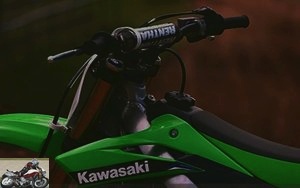
The heart of these slender grasshoppers is a 250 or 450 cc single cylinder, depending on the mood. Short skirt, external ribs and internal bridge cap with Bridged-box type reinforcement (exclusive on a production machine) give the forged piston more lightness and strength. Same research with titanium valves (intake: 31 mm; exhaust: 25 mm) reducing the masses in movement while offering more reliability at high speed. Equally remarkable, the 250’s single-cylinder is powered by two injectors, the first downstream of the throttle valve (conventional position), and the second upstream, near the airbox. These two elements each have a different role. The downstream injector provides a linear and instantaneous response, while the upstream injector takes care of the power. As the engine speed and throttle opening increase, the latter gradually takes over from the downstream injector. On the KX 250 F, the orifices of the two injectors are larger than on the KX 450 F in order to best supply the flow required by a high engine speed. Comparatively, the fuel flow is 20% higher on the Kawasaki quarter-liter.
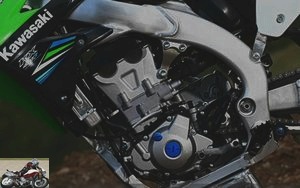
For more convenience, the pilot can choose three injection maps, among Standard (normal conditions), Hard (difficult conditions) and Soft (easy conditions). Just plug in one of the three supplied 4-pin DFI couplers to activate the corresponding motor profile (no, here it doesn’t change on the handlebars like on road machines). The location of the socket to the right of the steering column allows easy access without any dismantling of parts. As an option, a KX FI injection calibration set makes it possible to adjust these three programs more personally (mixture richness, ignition timing, etc.). Another technological point, the KX250F 2014 is equipped with the "Launch Control" mode very close to that of the factory KX, and already present on the 450. By pressing a button, the pilot can activate a separate map of engine settings which optimizes the chances of getting a good start in the race on slippery ground.
Another improvement is that the selection is easier and more durable (shorter selection range) and the gearbox is optimized. Finally, the KX benefit from an automatic decompression system. This centrifugal system with weights, located at the end of the exhaust camshaft, facilitates starting.
The main updates are in the suspensions. Like the factory Kawasaki, the fork and shock adjusters are coated with blue anodized aluminum. The new Uni-Trak rear suspension system features a tie rod located under the brushed aluminum swingarm, which increases the range of travel, allows finer adjustment and also improves rear wheel traction. A nitrogen cylinder pressurizes the combined unit and guarantees constant performance despite overheating..
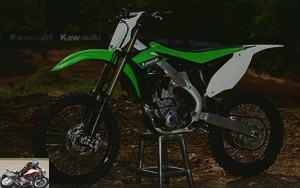
The KX250F was the first production cross-country machine to benefit from a Showa Separated Function Front Fork (SFF), which separates the damping function from the shock absorption function; left fork tube: shock absorber, right tube: spring. Since 2013, the inner tubes of larger diameter (ø48 mm) and the Type 2 structure improve the quality of the damping, the riding comfort, the resistance to bottoming out, and finally the stability when braking and when landing jumps. As the fork now has only one spring, the friction between the spring and the inner tube is reduced considerably (by about 25%) and the work becomes even more flexible over the entire length of travel. In addition, the use of damping pistons of larger diameter promotes the progressiveness of the suspension work. The disappearance of the straight tube damper assembly also frees up space for preload adjustment.
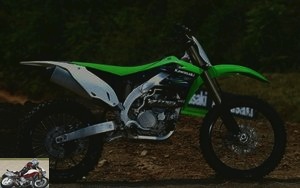
Even more efficient, the KX 450 F comes standard with an air-damped fork instead of springs. The advantage is a reduced weight (- 750g), simplified adjustments and a greater possibility of adjustments. Thanks to a special adapter (supplied with the motorcycle), a simple bicycle pump equipped with a pressure gauge can be used to adjust the value. As on the little sister, the inside diameter of the fork tubes could be increased, approximately doubling the damping working surface of the piston. As a result, better resistance to bottoming out and greater progressiveness.
Front and rear, Kawasaki are equipped with petal disc brakes (252 mm double pistons and 240 mm single clamp). On the steering gear element, a new pushrod master cylinder and new pads with higher coefficient of friction improve braking force and control..
The owner’s turn is over, it’s time to get on these MX Replica, ready to do the laps with the knees on the ground. Finally, I understand myself…
On track
The road and earth universes ultimately have in common only the passion of their practitioner, a handlebars and two wheels. Then everything is different, even the vocabulary. From the circuit, we can gauge the "Velodromes", "Tables", "Camels" or other "Woops"…. Finally, the displacements mentioned never exceed half a liter. However, discovering these long-legged machines, and although familiar with the use of much more robust machines, Mr. Clean is in super-stealth mode. There are figures that leave one wondering: weight 106 kg, power 43 horses…. and a competition manufacturing which augurs a character as pleasant as that of a chief mechanic one evening of defeat of his team.
It is therefore serene and sure of myself, Coue method, that I am about to take part in my first "country race". Time to kick properly my KX 250 F and my colleagues are already roaring and bouncing. Difficult to take its marks when everything is unknown. The ground, the tires, the machine…. To assimilate the essentials is already a challenge. The most delicate is ultimately the feeling, or rather the lack of feeling of the front axle. Unpleasant feeling that everything is moving and ganging up against the pilot.
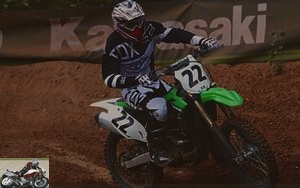
In this world of instability I seek my trace, for lack of trajectory. Fortunately, the circuit chosen is not extreme, allowing the Boeotian that I am to straddle its contrasting backbone. Copiously watered before our arrival, its surface alternates between dry and muddy parts. In the latter, I avoid initially, as much as possible, to put my crampons too much. Alas, the chain of difficulties does not take long to precipitate me there. With more or less happiness, I manage to finish a first session, at the end of which the first observation is: the day will be long ….
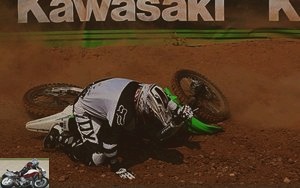
After a few minutes of rest, I begin to analyze the discipline, following the wise advice of experienced colleagues. My position, not very academic, prevents me from turning, taking bumps and tires me unnecessarily. Briefed on the basics of piloting, I took back control of my quarter-liter with much better results. The KX reacts finely to the support of the legs, its light and lively geometry obeying the slightest pressure. Ideal for regulars and reassuring for a beginner, the 250 can be taken quickly with a lot of pleasure. I then decided to focus on this medium model, the 450 representing a much higher category in terms of requirements. The machine takes more turns and its power, much more difficult to manage, does not match my inexperience..
As the laps progress, the (good) positions start to become more natural, allowing me to increase my pace of passage. The Kawasaki is almost forgotten, letting me try techniques to better understand the obstacles. Only the sometimes brutal injection on the go-around and a complicated regime to keep on the brittle ground causes me concern. Apart from this point, the KX 250 F is a machine to swallow the difficulties, its suspensions erasing most of the shocks. Ridden by the most imposing templates, they may however follow on the most violent compressions. Those of the 450 deliver superior approval and seem limitless.

More comfortable, I push the single cylinder a little on the few open spaces. The boiler displays a respectable health, picking up easily at low speed but bombarding quickly towards the higher spheres. The exits of the velodromes are lively, expelling the crew towards the next natural springboard. This lively character is handled fairly well with the clutch when passing through curves on soft ground. The front axle then finds its way and provides excellent guidance. Despite better ease, my ambitions bite the dust again when braking too hard. The equipment is highly efficient but requires a little experience to be finely dosed. Sliding with the rear requires a certain control or you risk stalling. The time to straighten the machine, notice that the kick is rather flexible to use and I go to the stand to change the clutch lever "a little" twisted. The job returns more or less smoothly…
At the end of this day of testing, the results are highly positive. If I cannot judge in all objectivity all the technical aspects of the KX, the pleasure and ease aspect is undeniable. Each new session brought its share of satisfaction, far from my grueling start.
Part-cycle
Lively, precise and light, the KX 250 F and 450 F are true offshoots of the world of competition. Their great agility even requires a little restraint from the less experienced pilots, under penalty of generating involuntary movements. Particularly high-quality, the on-board equipment will satisfy the most successful amateurs..
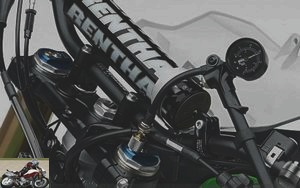
Braking
Efficient, the whole provides excellent decelerations. Biting and enduring, braking is very effective. The rear system is particularly convincing, making it possible to refine the trajectories and optimize the maneuvers.
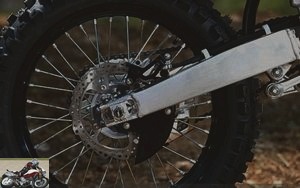
Conclusion
The KX legend continues its march, assured of a constant succession and under surveillance. Constantly improved, Kawasaki spearheads stand up to many rivals. Particularly present, the Japanese manufacturers offer a wide choice. Yamaha thus opposes its YZ250F and YZ450F asking for € 7,499 and € 7,999, a particularly attractive price. Suzuki draws its RM-Z250 and RM-Z450 for € 7,699 and € 8,299 while Honda offers its CRF250R and CRF450R for € 7,890 and € 8,690. Finally, at KTM, we can mention the 250 SX-F and 450 SX-F, lighter than the green ones and available, at a high price, against 8,450 € and 9 .260 €.
Placed, the Kawasaki are displayed at € 7,999 and € 8,699. Their general services, their meticulous construction and their filiation enamelled with international success are an undeniable guarantee of quality. As a reminder, the family also includes the KX 85 "big wheels" (€ 4,899)
and "small wheels" (4.799 €) as well as a 65 cm3 model.
Machine dedicated to high-level performance, the KX allows you to constantly improve your skills and increase in displacement if necessary. The universe of customer competition is not far away, a pledge for everyone to own a part of the Green Team legend.
Strong points
- Motor character
- Performances
- Cycle part
- Finishes and equipment
Weak points
- Suspensions that can tail on big shocks (KX 250 F)
Competitors: Ducati Mostro 620, Honda CBF 500, Honda CBF 600, Suzuki SV 650
Colors
Green
User reactions and testimonials on the
motorcycle guide
Related articles
-
Triumph Bonneville Bobber Black test
2 cylinders in line, 1200 cc, 77 hp at 6100 rpm, 106 Nm at 4000 rpm, 237.5 kilos dry, from ¤ 14 350 More muscle, more techno, more dark for the Bobber Is…
-
Kawasaki VN 1700 Voyager Custom ABS review
Kawa makes the clone …. With her very sleek lowered silhouette and plethora of equipment, this slanted-eyed American is largely inspired by the Harley…
-
4 cylinders in line, compressor, 998 cm3, 210 hp at 11,000 rpm, 137.3 Nm at 9,500 rpm, 260 kilos, € 21,999 Kawasaki reinvents the super-fast and…
-
Test Yamaha XT 1200 ZE Super Tenere
E. character slipper XT …, Tenere … some legends can be found in a few signs. In this case, that of Yamaha trails. Driven by the greatest rally…
-
Aprilia RS 660 motorcycle test
Root of RSV4 = RS 660 Parallel twin, 659 cm3, 100 hp, 67 Nm, 183 kg, A2 version, APRC pack, 11,050 euros Sportiness is the emblem of the Aprilia firm,…
-
Yamaha MT-125 and YZF R125 test
Mini urban and sporty pocket Terror The tuning forks brand has found the right tone for its new MT range. Unveiled at the end of 2013 and the beginning…
-
TGV first class Five years ago, Kawasaki presented its first Z1000SX, a road version of its Z 1000 reference roadster. A versatile machine, which has…
-
Kawasaki Ninja 1000 SX motorcycle test
Compromise without compromise 4 cylinders of 1,043 cm3, 142 hp and 111 Nm, 235 kg, from 14,349 euros In 2010, Kawasaki presented its first Z1000SX, a…
-
Kawasaki ER-6 N motorcycle test
A very stylish and punchy little urban The city of Mozart sounded for three days of a superb symphony in major exhaust. Orchestrated by Kawasaki making…
-
Honda Africa Twin test in the mud
Three levels of traction control, disconnectable ABS, DCT: useful, or not ? A life-size test at the Honda Adventure Center in Wales A real commercial…